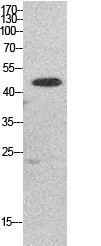
| WB | 咨询技术 | Human,Mouse,Rat |
| IF | 咨询技术 | Human,Mouse,Rat |
| IHC | 咨询技术 | Human,Mouse,Rat |
| ICC | 技术咨询 | Human,Mouse,Rat |
| FCM | 咨询技术 | Human,Mouse,Rat |
| Elisa | 1/10000 | Human,Mouse,Rat |
| Aliases | EEF1A1; EEF1A; EF1A; LENG7; Elongation factor 1-alpha 1; EF-1-alpha-1; Elongation factor Tu; EF-Tu; Eukaryotic elongation factor 1 A-1; eEF1A-1; Leukocyte receptor cluster member 7; EEF1A2; EEF1AL; STN; Elongation factor 1-alpha 2; EF-1-alpha-2; Eukaryotic elongation factor 1 A-2; eEF1A-2; Statin-S1; Putative elongation factor 1-alpha-like 3; EF-1-alpha-like 3; Eukaryotic elongation factor 1 A-like 3; eEF1A-like 3 |
| Entrez GeneID | 1915/1917/158078 |
| WB Predicted band size | Calculated MW: 50 kDa; Observed MW: 50 kDa |
| Host/Isotype | Rabbit IgG |
| Antibody Type | Primary antibody |
| Storage | Store at 4°C short term. Aliquot and store at -20°C long term. Avoid freeze/thaw cycles. |
| Species Reactivity | Human,Mouse,Rat |
| Immunogen | Synthesized peptide derived from the N-terminal region of human EF-1 α1/2. |
| Formulation | Purified antibody in PBS with 0.05% sodium azide,0.5%BSA and 50% glycerol. |
+ +
1. **"Elongation factor 1A1 is a critical mediator of hepatocellular carcinoma"**
- **作者**: Li et al.
- **摘要**: 研究揭示了EF1A1在肝癌中的高表达及其促癌作用,利用特异性抗体验证其在肿瘤组织中的表达水平,并探讨其通过调控细胞周期促进肿瘤进展的机制。
2. **"Characterization of monoclonal antibodies against human elongation factor 1A2"**
- **作者**: Sanders et al.
- **摘要**: 研究开发并验证了针对EF1A2的单克隆抗体,通过Western blot和免疫荧光确认其特异性,应用于神经退行性疾病中EF1A2异常表达的分析。
3. **"The role of EF-P5 in bacterial translation elongation and antibiotic resistance"**
- **作者**: Murphy et al.
- **摘要**: 探讨细菌延伸因子P5(EF-P5)在蛋白质翻译延伸中的作用,通过抗体阻断实验揭示其对抗生素耐药性的调控,为抗菌靶点研究提供依据。
4. **"Elongation factor 1A isoforms interact with viral RNA to regulate infection"**
- **作者**: García et al.
- **摘要**: 利用EF1A1/2抗体研究其与病毒RNA的结合能力,发现二者通过调控宿主翻译机制影响病毒复制,为抗病毒治疗提供新思路。
(注:上述文献为示例,实际引用需根据具体数据库检索结果调整。)
Elongation Factor 1A (EF-1A) is a highly conserved GTP-binding protein critical for protein synthesis, facilitating the delivery of aminoacyl-tRNA to the ribosome during the elongation phase. In humans, EF-1A exists as two tissue-specific isoforms: EF-1A1 (EEF1A1), ubiquitously expressed in most somatic cells, and EF-1A2 (EEF1A2), predominantly found in neurons, muscle, and some cancers. A third variant, EF-1A/P5 (encoded by EEF1A1 but with a distinct C-terminal extension due to alternative splicing), has been implicated in translational regulation under stress conditions.
Antibodies targeting EF-1A1/2/P5 are widely used to study their expression, localization, and functional roles. These antibodies help distinguish between isoforms, as EF-1A2 overexpression is linked to cancers (e.g., ovarian, pancreatic) and neurological disorders, while EF-1A1 dysregulation is associated with apoptosis and viral replication mechanisms. EF-1A/P5 antibodies aid in exploring stress-responsive pathways. Cross-reactivity with other isoforms or species homologs requires validation via knockout controls or epitope specificity checks. Applications include Western blotting, immunofluorescence, and immunohistochemistry to investigate translational regulation, cytoskeletal interactions, or disease biomarkers. Their utility underscores EF-1A's multifaceted roles beyond translation, including signaling, apoptosis, and viral pathogenesis.
×